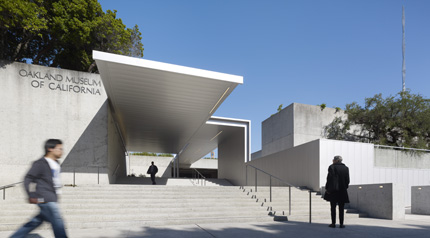
Take one iconic mid-modern museum, age it 40 years, stir in evolved exhibition techniques, and lightly toss with a sensitive renovation. Chef (and architect) Mark Cavagnero has done just that, and the result is the skillfully recrafted Oakland Museum of California.
Originally designed by Roche and Dinkeloo in 1969, the museum has been lauded as a Brutalist tour de force. Critic Ada Louise Huxtable termed it “revolutionary” at the time. But changing approaches to museum exhibition practices had rendered the building in need of a serious makeover. Furthermore, the series of small exhibit spaces of the original design made the type of cross-disciplinary displays now in vogue nearly impossible.
With two million objects in its collection, the museum also had a serious storage problem. The creation of the California Collections and Research Center, although not accessible to the public, was a critical component of the redesign. Reconfiguring the museum entrance, Cavagnero added a 90-foot sky-lit canopy that emphatically beckons to Oak Street, replacing the ineffective 10th Street entrance.
The Galleries of California Art and History, the first of several gallery spaces to be reconfigured, have been melded into one free-flowing space. The gallery lighting has been enhanced and the overall flexibility of the space improved. Further renovation of the Natural Sciences Gallery and educational and classroom spaces is scheduled for completion in 2012.
Renovations of strong architectural statements require a light touch; Cavagnero carefully adjusted the floor plan without altering the original design concept or aesthetic. Apart from the entry canopy, the casual observer might not recognize that a significant renovation has taken place. The improved functionality of the museum, however, is readily sensed. It is easier to locate oneself within the building, and moving about is more intuitive— always desirable characteristics of good architecture. Unchanged were Roche and Dinkeloo’s concrete planar elements, rooftop gardens, and strong horizontal sequencing. Cavagnero’s hand is scarcely felt, yet the result is a more workable and well-experienced museum.
The brief Brutalist movement found little expression in the Bay Area (Golden Gate University in San Francisco being the other prominent example) and certainly the Oakland Museum of California was the major work within the style. Renovating a well-known structure is an exercise fraught with difficulty. Copy the existing style and it’s campy, make a completely new architectural statement and the original is diminished or even lost.
In Cavagnero’s hands, neither occurs. Instead, he has found that elusive middle ground where the existing building retains its power and the additions improve on the past. The task was all the more challenging because the building program had evolved beyond its floor plan. Cavagnero’s relocating of the entrance, his interior reorganization of galleries, and the expansion of the collections and research areas brought the building’s spatial arrangement and mission back into harmony. The result is a public edifice now ready to serve and educate in our time. The “museum of the people,” as Roche termed it originally, lives refreshed and renewed, ready to reveal the richness of California history, art, and natural science.